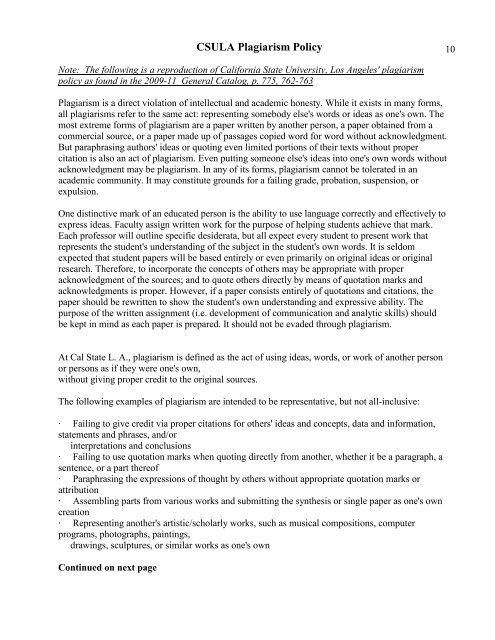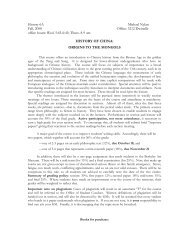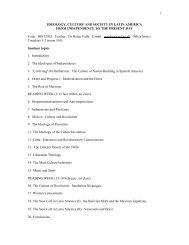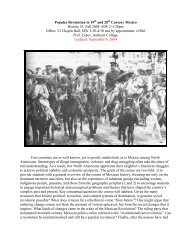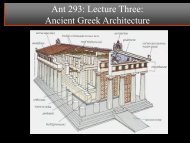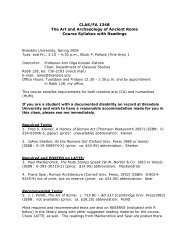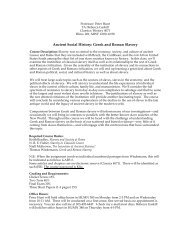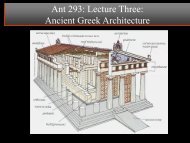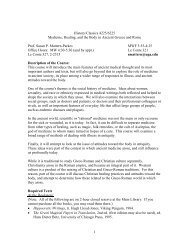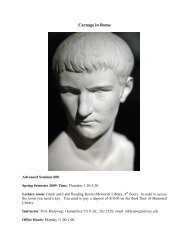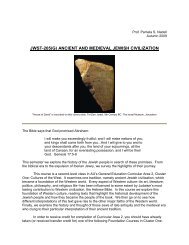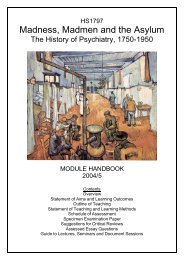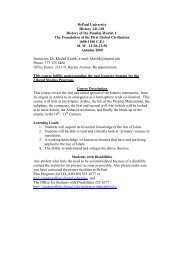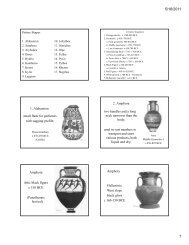HIST 426 The French Revolution and Napoleon
HIST 426 The French Revolution and Napoleon
HIST 426 The French Revolution and Napoleon
You also want an ePaper? Increase the reach of your titles
YUMPU automatically turns print PDFs into web optimized ePapers that Google loves.
CSULA Plagiarism Policy<br />
Note: <strong>The</strong> following is a reproduction of California State University, Los Angeles' plagiarism<br />
policy as found in the 2009-11 General Catalog, p. 775, 762-763<br />
Plagiarism is a direct violation of intellectual <strong>and</strong> academic honesty. While it exists in many forms,<br />
all plagiarisms refer to the same act: representing somebody else's words or ideas as one's own. <strong>The</strong><br />
most extreme forms of plagiarism are a paper written by another person, a paper obtained from a<br />
commercial source, or a paper made up of passages copied word for word without acknowledgment.<br />
But paraphrasing authors' ideas or quoting even limited portions of their texts without proper<br />
citation is also an act of plagiarism. Even putting someone else's ideas into one's own words without<br />
acknowledgment may be plagiarism. In any of its forms, plagiarism cannot be tolerated in an<br />
academic community. It may constitute grounds for a failing grade, probation, suspension, or<br />
expulsion.<br />
One distinctive mark of an educated person is the ability to use language correctly <strong>and</strong> effectively to<br />
express ideas. Faculty assign written work for the purpose of helping students achieve that mark.<br />
Each professor will outline specific desiderata, but all expect every student to present work that<br />
represents the student's underst<strong>and</strong>ing of the subject in the student's own words. It is seldom<br />
expected that student papers will be based entirely or even primarily on original ideas or original<br />
research. <strong>The</strong>refore, to incorporate the concepts of others may be appropriate with proper<br />
acknowledgment of the sources; <strong>and</strong> to quote others directly by means of quotation marks <strong>and</strong><br />
acknowledgments is proper. However, if a paper consists entirely of quotations <strong>and</strong> citations, the<br />
paper should be rewritten to show the student's own underst<strong>and</strong>ing <strong>and</strong> expressive ability. <strong>The</strong><br />
purpose of the written assignment (i.e. development of communication <strong>and</strong> analytic skills) should<br />
be kept in mind as each paper is prepared. It should not be evaded through plagiarism.<br />
At Cal State L. A., plagiarism is defined as the act of using ideas, words, or work of another person<br />
or persons as if they were one's own,<br />
without giving proper credit to the original sources.<br />
<strong>The</strong> following examples of plagiarism are intended to be representative, but not all-inclusive:<br />
· Failing to give credit via proper citations for others' ideas <strong>and</strong> concepts, data <strong>and</strong> information,<br />
statements <strong>and</strong> phrases, <strong>and</strong>/or<br />
interpretations <strong>and</strong> conclusions<br />
· Failing to use quotation marks when quoting directly from another, whether it be a paragraph, a<br />
sentence, or a part thereof<br />
· Paraphrasing the expressions of thought by others without appropriate quotation marks or<br />
attribution<br />
· Assembling parts from various works <strong>and</strong> submitting the synthesis or single paper as one's own<br />
creation<br />
· Representing another's artistic/scholarly works, such as musical compositions, computer<br />
programs, photographs, paintings,<br />
drawings, sculptures, or similar works as one's own<br />
Continued on next page<br />
10


